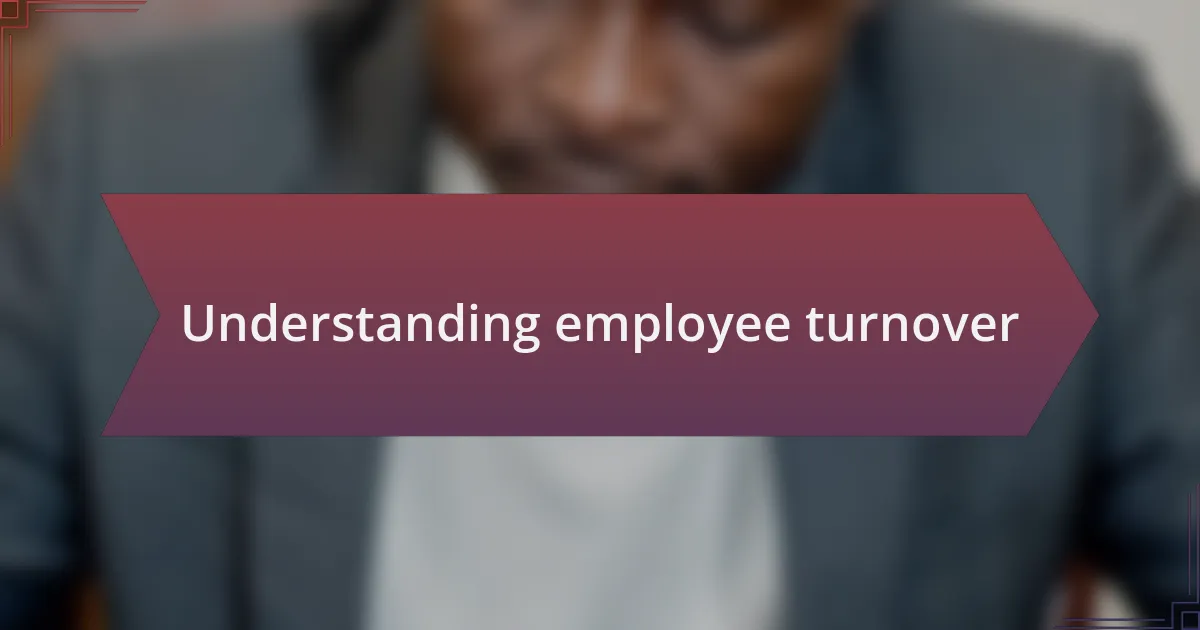Key takeaways:
- Employee turnover impacts team dynamics and productivity, necessitating a deeper understanding of its causes and effects.
- Addressing turnover proactively through strategies such as open communication, recognition, and professional development can enhance employee loyalty.
- Understanding employment law is essential for managing turnover effectively and mitigating legal risks associated with departures.
- Implementing practices like exit interviews and fostering mentorship programs can uncover valuable insights and improve retention efforts.

Understanding employee turnover
Employee turnover is a multifaceted issue that goes beyond simply counting how many people leave a company. I remember when I first encountered high turnover rates in a previous role; it felt like a revolving door. One moment, I was building rapport with a team member, and the next, they were gone, leaving a gap not just in productivity but in team morale.
Managing turnover requires understanding its causes, from job dissatisfaction to a lack of career advancement opportunities. Have you ever reflected on why a colleague left? It surprised me how often personal reasons intertwined with organizational culture, influencing decisions that seemed unrelated on the surface.
The emotional toll of turnover can be significant, affecting both the departing employee and those left behind. Often, I found that teams struggled with trust and cohesion, which are crucial for effective collaboration. How can we create an environment that encourages employees to stay? This question has driven me to explore ways to foster a supportive workplace culture that addresses the root causes of turnover.

Importance of addressing turnover
Addressing employee turnover is crucial for maintaining a healthy work environment. I remember a time when our department faced a wave of resignations, and the impact was palpable. It wasn’t just the loss of skills but the underlying anxiety among those of us who remained; we couldn’t help but wonder who might leave next or if we would be next in line.
When turnover goes unaddressed, it can lead to a cycle of instability that affects productivity levels. I often saw how new hires were thrust into roles without proper onboarding, leaving them feeling overwhelmed and unsure. Have you ever felt like you were thrown into the deep end without any lifebuoy? This experience can lead to further turnover as these new employees seek out more supportive environments.
Moreover, the costs associated with turnover extend beyond hiring and training. I recall analyzing our budget after a series of departures and realizing that lost productivity during the transition period was staggering. How many opportunities were we missing because we were constantly in recruitment mode instead of focusing on growth? This clarity reinforced my belief that tackling turnover head-on is not just a necessity; it’s a strategic imperative for any organization.

Overview of employment law
Employment law encompasses a wide range of regulations that govern the relationship between employers and employees. It includes everything from hiring practices and workplace safety to employee rights and termination procedures. I often think about how understanding these laws is essential—not just for compliance, but for building a respectful workplace.
Key regulations, such as the Fair Labor Standards Act and the Occupational Safety and Health Act, aim to protect employees from exploitation and unsafe conditions. I remember sitting in a training session where we discussed these laws, and it became clear to me how crucial these protections are. Have you ever pondered how different your work life could be without these safeguards?
In my experience, staying informed about employment law can significantly mitigate risks associated with turnover. I’ve seen firsthand how clear communication about workplace policies makes employees feel valued and secure. When employees recognize that their rights are respected, they’re more likely to remain committed to their roles. Isn’t it interesting how a solid grasp of these laws can pave the way for a more stable and engaged workforce?

Legal implications of turnover
When I think about the legal implications of turnover, several factors come to mind. For instance, employers must navigate the labyrinth of laws governing severance packages and final paychecks. I once witnessed a company face heavy fines simply because they failed to provide timely final wages to departing employees. Have you ever considered how just one oversight can lead to substantial financial repercussions?
Another critical aspect is the risk of discrimination and wrongful termination claims. I’ve seen organizations struggle with lawsuits after a sudden layoff, especially when the decision-making process wasn’t transparent. It’s crucial to ensure that any turnover is well-documented and justified. What if the reasons behind an employee’s exit are misunderstood or mishandled?
Moreover, turnover can impact the company’s compliance with various regulations surrounding employee benefits and health insurance coverage. I remember analyzing case studies where companies were caught off guard by the obligations to maintain benefits for departing employees. It’s eye-opening to realize that even the end of an employment relationship requires adherence to legal standards. How prepared is your organization to handle these complexities?

Strategies for retention success
One effective strategy for retention success lies in fostering a culture of open communication. I recall a time when I implemented regular check-ins with my team, creating a space where employees felt comfortable sharing their concerns and ideas. This simple practice not only boosted morale but also significantly reduced turnover in my department. Have you thought about how often you engage your employees in dialogue?
Another vital approach is recognizing and rewarding hard work. I remember implementing a peer recognition program that allowed team members to celebrate each other’s successes. The positive impact on the workplace atmosphere was palpable, resulting in increased loyalty and decreased turnover. When was the last time you acknowledged a job well done in your organization?
Additionally, investing in professional development can work wonders for retention. I’ve often seen employees leave not just for better pay, but for opportunities to grow in their careers. By providing training and mentorship, you show your commitment to their future, creating a sense of belonging that encourages them to stay. What opportunities for growth do you currently offer your employees?

Personal experience with turnover
When I first experienced a significant turnover in my team, it felt like a punch to the gut. I vividly remember the sense of loss after losing a few talented individuals who played crucial roles in our projects. It made me realize just how interconnected our team dynamics were and pushed me to introspect on what I could have done differently.
In another instance, I was blindsided when a promising employee resigned unexpectedly. It was during a busy quarter, and their departure not only left a gap in our workload but also impacted team morale. Reflecting on this experience taught me the importance of creating proactive engagement strategies. How often do we check in on employees’ overall satisfaction beyond their immediate tasks?
Looking back, I learned that turnover isn’t just a statistic; it’s a personal experience and a call to action. I’ve since become more intentional about understanding the motivations behind my employees’ choices. I often ask myself, could I have anticipated their needs better? This introspection has been invaluable in shaping my approach to employee retention, ensuring I foster a culture that prioritizes individual growth and well-being.

Best practices for responding effectively
When responding to employee turnover, one of the best practices I’ve implemented is conducting exit interviews. These conversations can uncover insights that may otherwise remain hidden. I remember a time when an employee mentioned feeling undervalued, which prompted me to reassess our recognition programs. Discussing these experiences not only empowers departing employees but also provides actionable feedback for improvement.
Another effective strategy has been to foster an open-door policy. I learned that small gestures, like regular check-ins or informal chats, can lead employees to share their thoughts and feelings before they reach a breaking point. It’s astonishing how often I’ve been surprised by the depth of concerns employees had—concerns that could have been addressed early on had I simply made space for those conversations. Are we truly listening to our team?
Moreover, I’ve found that investing in professional development initiatives pays dividends in retention. I once implemented a mentorship program that connected newer employees with seasoned staff. The energy and enthusiasm that emerged from these relationships not only improved morale but also helped in creating a more cohesive team. Have we considered how investing in our employees can transform our work environment? These simple yet powerful practices can make a significant difference in how we manage turnover.